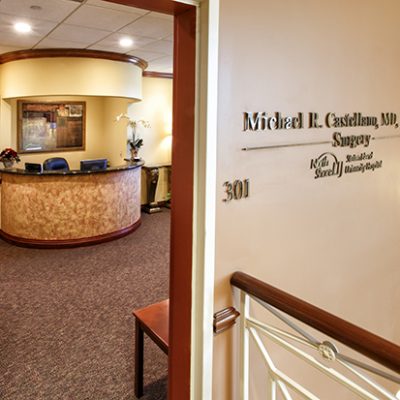
An expert in abdominal wall hernia treatment on why this condition, while common, requires subtly in diagnosis, a deft hand in treatment, and the wisdom to know when not to operate
By Jessica Jones-Gorman • Photos By Amessé Photography
When Dr. Michael R. Castellano joined the faculty at Staten Island University Hospital in 2013, one of his main goals was to form a center dedicated exclusively to the care and treatment of a common ailment: the abdominal wall hernia.
Hernias are common; nearly one in four men will get an inguinal hernia in their lifetime, and more than ten percent of men and women will have an umbilical hernia at some point. More than one million hernias are repaired in the United States annually. The question is which ones need to be fixed and which don’t.
“As a population, we are now heavier than ever, and many of us carry much of our weight on our abdominal wall,” Dr. Castellano explained. “We also move furniture, carry heavy packages, shovel snow, and lift heavy weights at the gym. This puts more strain on the abdominal wall, ultimately leading to weaknesses and defects.”
An abdominal hernia is simply a hole in the abdominal wall. Often, organs or fat will protrude through the hole resulting in a bulge. The most common form is an inguinal (groin) hernia, but there are others, such as umbilical (belly button), ventral (front of the abdominal cavity), and incisional (at the site of a previous surgery.) These bulges can be unsightly, uncomfortable, and often painful. Many are reducible, meaning the bulge can be easily pushed back into the abdominal cavity. Sometimes they will spontaneously reduce, usually during the night while sleeping. Some, however, are not reducible and this can represent an emergency. Knowing which hernias could potentially become problematic is difficult, and therefore consultation with an expert in this area is essential.
“The Hernia Center at Staten Island University Hospital will provide this resource to our community,” Castellano said.
This specialist in various areas of general, laparoscopic, and oncological surgery utilizes the latest techniques and advancements in minimally invasive surgery. He performs nearly all hernia repairs “tension-free,” using small incisions and using only local anesthesia with IV sedation (similar to that given during routine colonoscopies).
Most procedures take about 30 minutes, and patients are often on their way home one hour later, and are able to return to the normal activities of daily living within a week. Castellano has personally performed thousands of successful such hernia surgeries.
The elder son of an esteemed pulmonologist, this native Staten Islander earned his bachelor of science degree at Dickinson College in Carlisle, Pennsylvania before returning to New York to earn his Doctor of Medicine at SUNY Downstate. He completed surgical residency at Staten Island University Hospital before entering private practice in 2001. Over the past 13 years, he has built one of the largest surgical practices in the borough. He has also been the recipient of numerous awards and accolades for academic, teaching, research, and clinical achievement, and continues to remain actively involved in surgical education. Over the past 20 years, Castellano has published numerous articles in the medical literature and has presented original surgical research at many national and international conferences in Boston, Chicago, Miami, Dallas, and Cannes, France. He remains active in clinical research, too, and plans to further develop research projects and publications within the Department of Surgery with the opening of The Hernia Center.
The center’s “boutique” office is located on the hospital’s Seaview Avenue campus. Castellano performs all of his surgeries in SIUH’s modern, state-of-the-art ORs and its Center for Ambulatory Surgery.
“I am fortunate to work with a mature, knowledgeable, and compassionate office staff, as well as a dedicated team of skilled nurses, technicians, and anesthesiologists,” he said. “The benefits of working with the same team on a regular basis are numerous, but certainly include streamlined efficiency and communication, and ultimately improved quality of care. I believe the more you focus your attention on one thing, the better at it you become; the following quotation from 1804 by Sir Astley Paston Cooper, a noted English surgeon and anatomist, best illustrates why the field of hernia surgery has become a passion of mine and why Staten Island and the surrounding regions will benefit for years to come from The Hernia Center.”
“No disease of the human body, belonging to the province of the surgeon, requires in its treatment, a better combination of accurate, anatomical knowledge with surgical skill, than Hernia in all its varieties.” —Excerpt from the preface to his classic monograph The Anatomical and Surgical Treatment of Inguinal and Congenital Hernia. Sir Astley Paston Cooper, 1st Baronet (1768 – 1841).
SIUH Hernia Center
501 Seaview Ave., Suite 301 / 718.249.2900
siuh.edu/surgery / drcastellano.com









